Just (re)discovered by archivist Peter Rawson–the flag flown over the College during the Civil War, given back to the College by the great historian Samuel Eliot Morison (1887-1976), whose grandfather, Samuel Eliot (1821-1898) was professor of history and political science (1856-1874) and president of Trinity from 1860-64.

Comments Off on How cool is this??
 The College Archives has taken possession of what turned out to be 33 banker’s boxes of films (mostly fooball) from a storage unit on campus. The earliest films are from the late 1930s, and they seem to go up through the 1980s–games with other colleges, practices, training films, etc. We will be hiring students to produce an inventory, and creating a plan to better preserve and house these films, as well as looking to digitize the more significant footage for the use and enjoyment of our alumni, finances permitting! To facilitate this, we have borrowed a viewer & board to examine the films.
The College Archives has taken possession of what turned out to be 33 banker’s boxes of films (mostly fooball) from a storage unit on campus. The earliest films are from the late 1930s, and they seem to go up through the 1980s–games with other colleges, practices, training films, etc. We will be hiring students to produce an inventory, and creating a plan to better preserve and house these films, as well as looking to digitize the more significant footage for the use and enjoyment of our alumni, finances permitting! To facilitate this, we have borrowed a viewer & board to examine the films.
Comments Off on Football film archive

 A recent gift to the archives is what appears to be an early, self-published “edition” (ca. 1930s) of H. M. Dadourian’s Introduction to Analytic Geometry and the Calculus. We have a copy of a photo-reduced (“Lithoprinted”) typescript, slightly altered and dated 1947, as well as a copy of the 1949 edition published the Ronald Press (New York).
A recent gift to the archives is what appears to be an early, self-published “edition” (ca. 1930s) of H. M. Dadourian’s Introduction to Analytic Geometry and the Calculus. We have a copy of a photo-reduced (“Lithoprinted”) typescript, slightly altered and dated 1947, as well as a copy of the 1949 edition published the Ronald Press (New York).
Dadourian, born in Turkish Armenia in 1878, emigrated to the United States in 1900, took three degrees at Yale and then taught physics there for 10 years, served as an aeronautical engineer at Princeton during WWI and a few years after (1917-23), and was appointed Seabury professor of mathematics and natural philosophy at Trinity College from 1923–1949. He retired in 1949 but remained very active—supporting our intervention during WWII to prevent Germany from conquering Great Britain, and opposing nuclear testing, the development of nuclear weapons, and our involvement in Vietnam. He died in West Hartford in 1974.
“Among his most highly regarded courses at Trinity was one in advanced physics in which classical mechanics were studied by means of the mathematics of the 17th and 18th centuries. The mathematics were used as a tool to understand physical principles which in turn were reduced in large measure to a single principle called The Action Principle. Most of the course was devoted to furthering understanding of this principle by using it to solve problems. The course demonstrated that a great deal could be learned about nature from detailed and general examination of relatively simple problems, and that hypotheses could be proved wrong, although not right, without actual experiments. In his teaching, Dadourian emphasized the importance of stating a problem accurately in terms simple enough to permit mathematical translation.”
[From volume 58 of the National Cyclopedia of American Biography]
Comments Off on Cool physics professor
[Posted by Peter Rawson, Associate Curator of Archives & Manuscripts]
 The Chemical Prize Essay collection in the Trinity College Archives contains 327 chemical essays submitted by students at Trinity between 1858 and 1905.
The Chemical Prize Essay collection in the Trinity College Archives contains 327 chemical essays submitted by students at Trinity between 1858 and 1905.
These essays were submitted as part of a competition among students in to win the first place prize of $30 and the second place prize of $20.
The prize began in 1858 as a contest for seniors and became a junior prize in the mid-1880’s.
Essays were submitted to the Professor of Chemistry. These included Rev. Thomas R. Pynchon, Scoville Professor of Chemistry and Natural Science, 1854-1879; H. Carrington Bolton, Scoville Professor of Chemistry and Natural Science, 1880-1887; Robert B. Riggs (pictured here), Scoville Professor of Chemistry and Natural Science, 1888-1929.
 The assigned essay topic each year was predetermined, with topics concerning chemicals, new technology, plants, light, or the metric system. The essays are organized in alphabetical order of the essayists’ last names, and they include both the winning essays and the other contestants’ essays.
The assigned essay topic each year was predetermined, with topics concerning chemicals, new technology, plants, light, or the metric system. The essays are organized in alphabetical order of the essayists’ last names, and they include both the winning essays and the other contestants’ essays.
 Jarvis Lab (undated)
Jarvis Lab (undated)
Comments Off on Prize-winning Chemistry Essays
 Members of the current Tripod staff were able to benefit from the wisdom of several alumni who worked on the paper in their time at Trinity, and came in today to look at the exhibition “Ten Decades of the Tripod.”
Members of the current Tripod staff were able to benefit from the wisdom of several alumni who worked on the paper in their time at Trinity, and came in today to look at the exhibition “Ten Decades of the Tripod.”
Ben Barber ’65 held forth to the students about the importance of editing, especially when the current editor revealed that many student contributors were offended by changes made to their copy.
“That’s journalism,” said Barber, a professional journalist for decades who currently writes for the Huffington Post, and who made it clear that every writer needs an editor. Barber left Trinity and “became a hippie,” as he says, roving through India and Thailand for ten years, writing poetry and selling stories to newspapers back in the US. He spoke at length with several students about writing and reporting.
 Robert Cockburn ’90, who also serves on the Board of Fellows, talked animatedly with the students and other alumni (Pat Sclafani ’83, and Patty Hooper Kelley ’82) and told stories of their days with the paper. A bit later Marybeth (Callan) Serdechny ’83 and Que (Ho) Witik ’83 dropped in and reminisced about the classmates they saw in the stacks of Tripods from the 1980s.
Robert Cockburn ’90, who also serves on the Board of Fellows, talked animatedly with the students and other alumni (Pat Sclafani ’83, and Patty Hooper Kelley ’82) and told stories of their days with the paper. A bit later Marybeth (Callan) Serdechny ’83 and Que (Ho) Witik ’83 dropped in and reminisced about the classmates they saw in the stacks of Tripods from the 1980s.
Another alumnus, Dan Kelman ’76, who served on the Tripod as a freelance photographer in the early 1970s, pointed out many of his pics and reminisced about his friend Dave Levin ’75, who went on to shoot photos for Sports Illustrated.
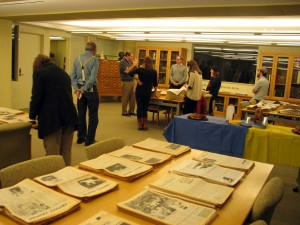
Comments Off on Homecoming visitors
 As I continue my survey of the College Archives I recently discovered two large three-ring binders containing typed notes for “A Survey of American Literature” taught by Kenneth Walter Cameron in the 1950-51 school year. These notes were donated to the archives by Hollis S. Burke, Class of 1951.
As I continue my survey of the College Archives I recently discovered two large three-ring binders containing typed notes for “A Survey of American Literature” taught by Kenneth Walter Cameron in the 1950-51 school year. These notes were donated to the archives by Hollis S. Burke, Class of 1951.
This led me to discover History of English and American Literature, by Charles F. Johnson, Professor of English Literature at Trinity from 1900-1931. 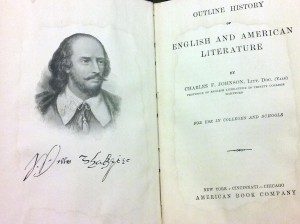 This work was published in 1900 and is part of the Trinitiana Collection. These archival treasures opened up some questions for me:
This work was published in 1900 and is part of the Trinitiana Collection. These archival treasures opened up some questions for me:
What were the works read in the literature classes?
What were the themes of the classes and questions posed by instructors?
How did this all change over time?
How were the classes taught?—lecture, seminar.
The Burke notebooks contain many transcribed passages from various literary analyses and critical works. Did students in the early 1950’s spend time transcribing these works themselves?

[Posted by Peter Rawson, Associate Curator of Archives & MS Collections]
Comments Off on Teaching literature @ Trinity
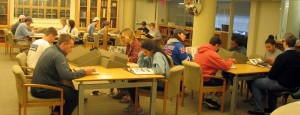 This morning we happily responded to a last-minute request to pull copies of the College yearbook (Ivy) dating from the 1950s and the 1980s for Jen Jack Gieseking’s American Studies 203 (“Conflicts & Cultures in American Society”) course. The students had recently seen the movie Back to the Future and were fascinated to look at what Trinity “looked like” in the 1950s vs. the 1980s, as professor Gieseking led them through the themes he wanted to cover–coeducation, racial equality, social norms and conflicts, etc.
This morning we happily responded to a last-minute request to pull copies of the College yearbook (Ivy) dating from the 1950s and the 1980s for Jen Jack Gieseking’s American Studies 203 (“Conflicts & Cultures in American Society”) course. The students had recently seen the movie Back to the Future and were fascinated to look at what Trinity “looked like” in the 1950s vs. the 1980s, as professor Gieseking led them through the themes he wanted to cover–coeducation, racial equality, social norms and conflicts, etc.
All of the Ivy’s are available online through our digital repository.
Comments Off on Back to the Future!
 …When you hold an event with minimal marketing and the die-hard supporters come out.
…When you hold an event with minimal marketing and the die-hard supporters come out.
Roughly a dozen folks came to our opening today, but we had a rather lively game of Trivia, some excellent cider and pumpkin bread (if I may say so), and dicoursed on how many themes in Trinity’s history seem to recur every few years! Look for this event again in a few weeks during Family Weekend and Homecoming!
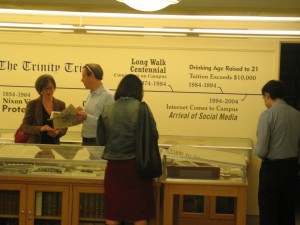
Comments Off on You know your friends…
[Posted by Peter Rawson, Associate Curator of Archives & Manuscript Collections]
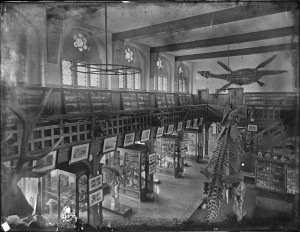
The survey of the College Archives continues! I happened upon a box on a high shelf that was deteriorating, crumbling, and very heavy. As I pulled it off the shelf the box came apart. I managed to place it in a secure location on another shelf before all of the contents fell to the ground. To my surprise I found over 150 glass plate photographic negatives dating from around 1850-1923.

These images include portraits of faculty, campus exteriors, interiors–including some dorm rooms, track practice, and a photograph of the Cabinet Room in Seabury Hall, which was the college museum.

With assistance of Naty Bush, a first-year student, and Special Collections Assistant Henry Arenth, we were able to temporarily re-box the slides and evaluate their condition. Next steps include more permanent re-housing and printing the slides.
Comments Off on Fragile Memories of Trinity
 Now that our 20-foot timeline for “Ten Decades of the Trinity Tripod” has been installed, we can finally open this exhibition!
Now that our 20-foot timeline for “Ten Decades of the Trinity Tripod” has been installed, we can finally open this exhibition!
The Watkinson Library invites the campus community to our opening during Common Hour (12:15-1:30) on Tuesday, October 6th, 2015. We will have light refreshments, and the event for the hour will be a running game of Trin-Trivia, a game devised by Head Curator Rick Ring to test your knowledge (and teach you a little something) about Trinity College history.
For those who show up and play, you will be able to win a “vintage” edition of the Tripod, or other cool bits of Trinitiana!
Comments Off on Exhibition opening
 The College Archives has taken possession of what turned out to be 33 banker’s boxes of films (mostly fooball) from a storage unit on campus. The earliest films are from the late 1930s, and they seem to go up through the 1980s–games with other colleges, practices, training films, etc. We will be hiring students to produce an inventory, and creating a plan to better preserve and house these films, as well as looking to digitize the more significant footage for the use and enjoyment of our alumni, finances permitting! To facilitate this, we have borrowed a viewer & board to examine the films.
The College Archives has taken possession of what turned out to be 33 banker’s boxes of films (mostly fooball) from a storage unit on campus. The earliest films are from the late 1930s, and they seem to go up through the 1980s–games with other colleges, practices, training films, etc. We will be hiring students to produce an inventory, and creating a plan to better preserve and house these films, as well as looking to digitize the more significant footage for the use and enjoyment of our alumni, finances permitting! To facilitate this, we have borrowed a viewer & board to examine the films.




















